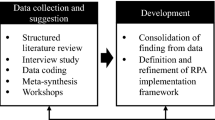Abstract
To finish in accordance with its originally planned duration or cost, a project that is not meeting its schedule or budget requires improved performance in the work that remains. This paper shows how to calculate the new productivity in terms of the average earned-value performance over the first part of a project, and it shows how the new productivity rate depends on the fraction of tasks completed. The completed task fraction beyond which recovery is impossible is calculated, and a point beyond which recovery is highly unlikely is suggested. Using an analytic approximation for an S-curve, these calculations are transformed into a temporal domain.


Similar content being viewed by others
References
Eden C et al (2000). On the nature of disruption and delay (D&D) in major projects. J Opl Res Soc 51: 291–300.
Brooks Jr FP (1995). The Mythical Man-Month, anniversary edition. Addison-Wesley: Boston.
Graves SB (1989). Why costs increase when projects accelerate. Res Tech Mngt 32 March–April: 16–18.
Cooper KG (1994). The $2000 hour: how managers influence project performance through the rework cycle. Proj Mngt J 25: 11–24.
Williams TM et al (1995). The effects of design changes and delays on project costs. J Opl Res Soc 46: 809–818.
Fleming QW and Koppelman JM (2000). Earned Value Project Management, 2nd edn. Project Management Institute, Inc.: Newtown Square, Pennsylvania.
Project Management Institute Standards Committee (2003). A Guide to the Project Management Body of Knowledge (PMBOK®), 3rd edn. Project Management Institute, Inc.: Newtown Square, Pennsylvania.
Anbari F (1980). An operating management control system for large-scale projects. Presentation given to American Institute for Decision Sciences, Ninth Annual Meeting, Northeast Regional Conference, Philadelphia.
Kerzner H (2003). Project Management: A Systems Approach to Planning, Scheduling, and Controlling, 8th edn, Chapter 15.5. New York: John Wiley and Sons, Inc., p 580f.
Zwikael O et al (2000). Evaluation of models for forecasting the final cost of a project. Proj Mngt J 31: 53.
Cioffi DF (2005). Designing project management: a scientific notation and an improved formalism for earned value calculations. Submitted to the Int J Proj Mngt accepted and in revision.
Cioffi DF (2005). A tool for managing projects: an analytic parameterization of the S-Curve. Int J Proj Mngt 23: 215–222.
Acknowledgements
I thank Homayoun Khamooshi for a careful reading and for catching an error in an earlier version, and an anonymous referee with helping place the material in a better context.
Author information
Authors and Affiliations
Corresponding author
Appendix A
Appendix A
Equations for the S-Curve solution
The normalized S-curve equation presented here, y(β) (where β is normalized time), asks the user to choose two parameters: 1) the slope of the rise in the middle part of the S-curve (r 0.67) and 2) the time at which approximately half the funds have been expended (β 1/2).12 The following set of expressions defines an S-curve in terms of these two values

where

and

As we desire, y=1 at the end of a project (y → y ∞>1 afterwards), and at β=β1/2, y=y ∞/2≈0.5. In the absence of any other information, choosing r 0.67=1 (two-thirds of the rise takes place in the middle third of the S) and β 1/2=0.5 yields the following explicit equation:

The above equation, used in the calculation in the main text, produces a typical S-curve. Increasing r 0.67 would sharpen the rise and flatten the curve at its two ends, but these changes would not change the nature of the results described above.
Rights and permissions
About this article
Cite this article
Cioffi, D. Completing projects according to plans: an earned-value improvement index. J Oper Res Soc 57, 290–295 (2006). https://doi.org/10.1057/palgrave.jors.2602007
Received:
Accepted:
Published:
Issue Date:
DOI: https://doi.org/10.1057/palgrave.jors.2602007




